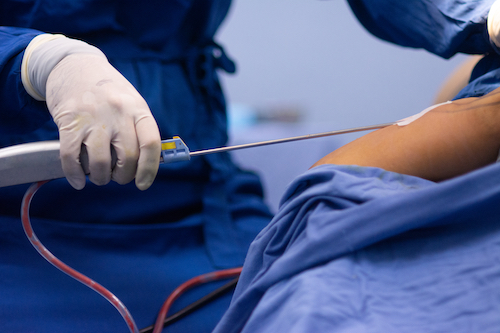Liposuction: What You Need to Know
Answers to your questions about cost, recovery, what to expect, etc.

In a world where appearance holds significant value, many individuals seek various methods to achieve their desired body shape. Liposuction, often hailed as a versatile cosmetic procedure, has gained immense popularity for its ability to remove stubborn fat deposits and sculpt the body. In this article, we will explore what liposuction is, the different types that exist, the cost, the recovery period, the importance of compression garments and nutrition, and setting reasonable expectations for the outcome.
What is Liposuction?
Liposuction, also known as lipoplasty or body contouring, is a surgical procedure designed to remove excess fat deposits from specific areas of the body. This cosmetic surgery can enhance body contours and proportions by eliminating stubborn pockets of fat that are resistant to diet and exercise.
Types of Liposuction
-
Traditional Liposuction: In this method, a cannula (a thin tube) is inserted through small incisions in the skin to vacuum out fat. It is the most established form of liposuction.
-
Tumescent Liposuction: This technique involves injecting a solution of saline, local anesthesia, and epinephrine into the targeted area. The solution helps to reduce bleeding and discomfort during the procedure.
-
Laser-Assisted Liposuction (LAL): LAL uses laser technology to liquefy fat cells, making them easier to remove. This method can result in less trauma to surrounding tissues.
-
Ultrasound-Assisted Liposuction (UAL): UAL employs ultrasound energy to emulsify fat cells, facilitating their removal. It is often used in areas with denser fat deposits.
-
Power-Assisted Liposuction (PAL): PAL uses a vibrating cannula to break up fat cells, making them easier to remove. It requires less manual effort, reducing surgeon fatigue.
Liposuction Costs
-
Variability in Costs: The cost of liposuction can vary significantly based on various factors, including the geographic location of the surgery center, the experience of the surgeon, the extent of the procedure, and the specific techniques used. On average, liposuction can cost anywhere from a few thousand to several thousand dollars.
-
Additional Expenses: It’s important to consider that the total cost may include not only the surgeon’s fees but also anesthesia fees, facility fees, pre-operative tests, post-operative garments, and follow-up appointments. Ensure that you receive a comprehensive quote before committing to the procedure.
-
Financing Options: Many individuals explore financing options or payment plans to make liposuction more affordable. Some plastic surgery centers offer financing arrangements to help patients manage the financial aspect of the procedure.
Common Fears Surrounding Liposuction
-
Anesthesia Concerns: The idea of being under anesthesia can be anxiety-inducing for some. However, liposuction is typically performed under either local anesthesia with sedation or general anesthesia, depending on the extent of the procedure. Your surgeon will discuss the best option for you during the consultation.
-
Pain and Discomfort: Post-operative pain is a common fear, but it’s worth noting that discomfort levels can vary among individuals. Surgeons often prescribe pain medications to manage any pain, and over time, the discomfort typically subsides during the recovery period.
-
Scarring: Liposuction incisions are usually small and strategically placed to minimize scarring. With proper care, these scars tend to fade over time and become less noticeable.
Recovery Period
The recovery period after liposuction can vary depending on the extent of the procedure and individual factors. However, here are some general guidelines:
-
Immediately After Surgery: Patients typically experience swelling, bruising, and some discomfort. Pain medication may be prescribed to manage any pain.
-
First Few Days: Rest and avoiding strenuous activities are essential during this period. Compression garments are usually worn to minimize swelling and promote proper healing.
-
First Few Weeks: Swelling and bruising gradually subside. Light activities may be resumed, but heavy lifting and strenuous exercise should be avoided until cleared by the surgeon.
-
Months Ahead: Final results may take several months to become apparent as the body heals and adapts to its new contours.
Compression Garments
Compression garments play a crucial role in the liposuction recovery process. They provide support to the treated areas, help reduce swelling, and promote optimal skin retraction. These garments should be worn as directed by your surgeon to ensure the best possible results.
Setting Reasonable Expectations
While liposuction can produce remarkable results, it’s essential to have realistic expectations. The procedure is not a replacement for weight loss or a solution for cellulite. It is best suited for individuals who are close to their ideal weight but struggle with localized fat deposits.
Remember that individual results vary, and factors such as genetics, lifestyle, and post-operative care can influence the outcome. Consultation with a board-certified plastic surgeon is crucial to discuss your goals and determine if liposuction is the right option for you.
Potential Complications of Liposuction
-
Infection: Although rare, infection is a possible complication after liposuction. Surgeons take strict precautions to maintain a sterile environment during the procedure and provide post-operative care instructions to minimize infection risk.
-
Bleeding and Bruising: Some bleeding and bruising are normal after liposuction. However, excessive bleeding can occur in rare cases. Compression garments, as recommended by your surgeon, can help reduce these risks.
-
Fluid Accumulation: Fluid buildup (seroma) or blood accumulation (hematoma) can occur after liposuction. These issues may require additional procedures to drain the fluids or blood.
-
Asymmetry or Irregularities: Achieving perfectly symmetrical results can be challenging, and there is a slight risk of asymmetry or contour irregularities after liposuction. Skilled surgeons aim to minimize these risks through precise techniques.
-
Numbness and Sensation Changes: Temporary numbness or altered sensation in the treated areas can occur, but these usually resolve over time.
Liposuction is a widely practiced cosmetic procedure with a proven track record of delivering impressive results. However, it’s essential to approach it with realistic expectations, understanding the potential costs, addressing common fears, and being aware of possible complications.
To ensure a safe and successful liposuction experience, choose a board-certified plastic surgeon who will thoroughly discuss the procedure, address your concerns, and provide post-operative care guidelines. By making informed decisions and taking proper precautions, you can enhance your chances of achieving the body contours you desire while minimizing the risks associated with the procedure.

